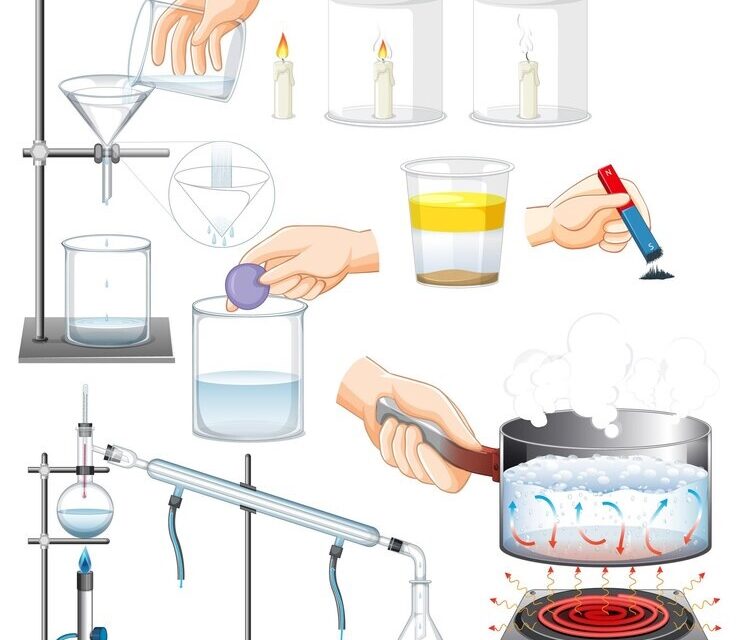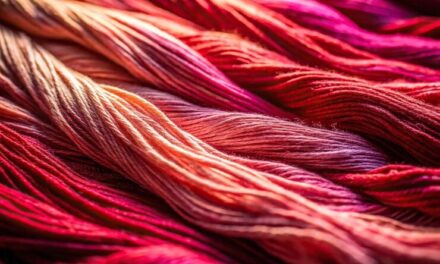Introduction to Mixtures and Pure Substances
In our everyday life, we encounter a variety of substances, from the air we breathe to the food we eat. These substances can be classified into two main categories: pure substances and mixtures. Understanding these concepts is crucial because they form the basis of many scientific processes, including how we separate substances.
What are Pure Substances?
A pure substance is a material that has a constant composition and properties throughout. This means that no matter how much of the substance you have, it will always have the same chemical composition. Pure substances can be elements or compounds.
Introduction to Mixtures and Pure Substances
In our everyday life, we encounter a variety of substances, from the air we breathe to the food we eat. These substances can be classified into two main categories: pure substances and mixtures. Understanding these concepts is crucial because they form the basis of many scientific processes, including how we separate substances.
What are Pure Substances?
A pure substance is a material that has a constant composition and properties throughout. This means that no matter how much of the substance you have, it will always have the same chemical composition. Pure substances can be elements or compounds.
– Elements: These are substances that cannot be broken down into simpler substances by chemical means. Examples include oxygen (O₂) and gold (Au).
– Compounds: These are substances composed of two or more elements that are chemically combined. Water (H₂O) and salt (NaCl) are examples.
Elements:
- Hydrogen (H) – The lightest and most abundant element in the universe.
- Oxygen (O) – A gas essential for respiration and the most abundant element in Earth’s crust.
- Carbon (C) – A fundamental element in organic compounds, found in all living organisms.
- Iron (Fe) – A metal commonly used in construction and manufacturing.
- Gold (Au) – A precious metal used in jewelry and electronics.
Compounds:
- Water (H₂O) – A compound of hydrogen and oxygen, essential for life.
- Carbon Dioxide (CO₂) – Composed of carbon and oxygen, it is a product of respiration and combustion.
- Sodium Chloride (NaCl) – Common table salt, made from sodium and chlorine.
- Methane (CH₄) – A compound of carbon and hydrogen, it’s a major component of natural gas.
- Calcium Carbonate (CaCO₃) – Found in limestone, chalk, and marble.
What are Mixtures?
A mixture is a physical combination of two or more pure substances where each substance retains its own chemical properties. Unlike pure substances, mixtures can vary in composition. Mixtures can be either homogeneous or heterogeneous.
Types of Mixtures
Homogeneous Mixtures
A homogeneous mixture is one in which the components are evenly distributed, and you cannot distinguish one part from another. Examples include:
– Solutions: Saltwater is a solution where salt is evenly dissolved in water.
– Alloys: Bronze is a homogeneous mixture of copper and tin.
Heterogeneous Mixtures
In a heterogeneous mixture, the components are not evenly distributed, and you can often see the different parts. Examples include:
– Salad: You can see and pick out the different vegetables.
– Sand and Salt: These can be distinguished and separated easily.
Properties of Mixtures
The properties of mixtures can vary depending on their composition. For instance, the melting and boiling points of mixtures are not always fixed and can change based on the proportions of the components.
Melting Point and Boiling Point
– Melting Point: This is the temperature at which a solid becomes a liquid. In mixtures, the melting point can be lower or higher than that of the pure substances.
– Boiling Point: This is the temperature at which a liquid becomes a gas. Like melting points, boiling points in mixtures can vary depending on their composition.
Here are some examples of mixtures and compounds:
Mixtures:
- Saltwater – A mixture of salt (sodium chloride) and water. It can be separated by physical means like evaporation.
- Air – A mixture of gases, mainly nitrogen, oxygen, and small amounts of carbon dioxide and other gases.
- Salad – A mixture of various vegetables, each retaining its properties.
- Sand and Iron Filings – These can be separated using a magnet, and each component keeps its own identity.
- Cereal with Milk – The cereal and milk don’t chemically combine, and each can be separated easily.
Compounds:
- Water (H₂O) – A chemical compound made from hydrogen and oxygen. The elements are chemically bonded, and you can’t separate them by physical means.
- Carbon Dioxide (CO₂) – A compound of carbon and oxygen, formed by chemical bonds.
- Sodium Chloride (NaCl) – Common table salt, made of sodium and chlorine bonded together.
- Glucose (C₆H₁₂O₆) – A sugar compound composed of carbon, hydrogen, and oxygen.
- Calcium Carbonate (CaCO₃) – Found in chalk, it is a compound of calcium, carbon, and oxygen.
Mixtures can be separated by physical processes, while compounds require chemical reactions to be broken down into simpler substances.
Why is Separation Necessary?
Separation of substances is a fundamental process in science and everyday life. Here’s why:
To Remove Undesirable Constituents
Sometimes, mixtures contain unwanted substances that need to be removed. For instance, separating impurities from drinking water to make it safe is essential.
To Obtain Useful Constituents
Separation allows us to isolate and use valuable components from mixtures. For example, separating sugar from a sugar-cane mixture provides us with the sweetener.
To Obtain Pure Substances
In many cases, pure substances are needed for various applications, such as in chemical reactions or medical uses. Separating pure substances from mixtures ensures their effectiveness.
Methods of Separation
Different methods are used to separate substances based on their physical properties. Let’s explore some common techniques:
Separating Solids from Other Solids
- Threshing and Winnowing
– Threshing: This method is used to separate grains from stalks. For example, when harvesting wheat, threshing involves beating the stalks to release the grain.
– Winnowing: After threshing, winnowing helps separate the grain from the chaff. This is done by pouring the mixture into the air so that the lighter chaff blows away while the heavier grains fall to the ground.
Experiment: Threshing and Winnowing
Materials: A small bundle of wheat stalks, a fan, and a sieve.
- Use the sieve to separate the wheat grains from the stalks by shaking it.
- Place the mixture of grains and chaff in front of a fan to separate the lighter chaff from the heavier grains.
- Handpicking and Sieving
– Handpicking: This is a simple method used to separate larger, easily distinguishable materials. For example, picking out stones from rice.
– Sieving: This involves passing a mixture through a sieve to separate particles based on size. For instance, separating fine flour from larger wheat bran.
Experiment: Handpicking and Sieving
Materials: A mixture of rice and stones, a sieve.
- Handpick the stones from the rice.
- Use the sieve to separate rice grains based on their size.
Separating Insoluble Solids from Liquids
- Sedimentation and Decantation
– Sedimentation: This method relies on gravity to separate solids from liquids. For instance, letting muddy water sit so that the mud settles at the bottom.
– Decantation: After sedimentation, the clear liquid can be carefully poured off, leaving the solid behind.
Experiment: Sedimentation and Decantation
Materials: Muddy water, a glass jar.
- Allow the muddy water to sit undisturbed until the mud settles at the bottom.
- Carefully pour the clear water into another container, leaving the mud behind.
_______________________________________________________
If the sediments float then also it is decantation?
Decantation is a separation method typically used when you have:
- A liquid and an insoluble solid, or
- Two immiscible liquids (liquids that don’t mix, like oil and water)
Traditionally, decantation is used when the solid settles at the bottom (sediments) and the liquid is poured off the top. However, the principle can apply to floating materials as well. Here’s a more detailed explanation:
- If sediments sink: This is the classic case of decantation. The liquid is carefully poured off, leaving the sediments behind.
- If sediments float: Yes, you can still use decantation! In this case, you would carefully pour out the liquid from underneath, leaving the floating materials behind. This is sometimes called inverse decantation.
Examples of decantation with floating materials:
- Removing cream from the top of milk
- Skimming oil off the surface of water
It’s worth noting that while this process can still be called decantation, there are often more specific terms used depending on the context:
- Skimming: Removing a floating liquid or light solid from the surface of another liquid
- Flotation: A process used in industry where air bubbles are attached to specific materials to make them float for easier separation
The key principle of decantation – separating substances based on their different densities and the fact that they don’t mix – applies whether the material you’re separating sinks or floats.
_____________________________________________
- Filtration
– Filtration: This method uses a filter paper or mesh to separate solids from liquids. For example, filtering coffee grounds from brewed coffee.
Experiment: Filtration
Materials: Coffee filter, coffee grounds, water.
- Pour a mixture of coffee grounds and water through the coffee filter placed in a funnel.
- Collect the filtered coffee in a container below. # Filtration: Separating Mixtures
What is Filtration?
Filtration is a method used to separate solid particles from a liquid or gas. It’s a process we see and use in many aspects of our daily lives, from making coffee to keeping our water clean. Let’s dive deeper into understanding how filtration works!
How Does Filtration Work?
Filtration works by passing a mixture through a filter. The filter has tiny holes or pores that allow some parts of the mixture to pass through while blocking others.
– The liquid or gas that passes through the filter is called the filtrate.
– The solid that gets caught by the filter is called the residue.
Think of it like a net catching fish in a river. The water passes through, but the fish get caught.
Components of Filtration
- Mixture: This is what you’re trying to separate. It contains both the substance you want (usually a liquid) and the substance you don’t want (usually solid particles).
- Filter: This is the barrier that separates the components of the mixture. It can be paper, cloth, sand, or even coffee filters!
- Filtrate: The liquid or gas that passes through the filter.
- Residue: The solid particles that get caught by the filter.
Types of Filters
There are many types of filters, each suited for different purposes:
- Paper filters: Used in coffee makers and some science experiments.
- Cloth filters: Used in some types of cooking and in air conditioning units.
- Sand filters: Used in large-scale water treatment plants.
- Membrane filters: Used in advanced water purification systems.
Examples of Filtration in Everyday Life
- Making Coffee or Tea:
– When you brew coffee or steep tea, you’re using filtration!
– The coffee grounds or tea leaves are separated from the liquid using a filter.
- Water Treatment:
– Cities use large filtration systems to clean water before it reaches our homes.
– The water passes through several filters to remove dirt, debris, and harmful bacteria.
- Aquarium Maintenance:
– Fish tanks use filters to keep the water clean for the fish.
– The filter removes waste products and uneaten food from the water.
- Air Conditioning:
– Air conditioners and many vacuum cleaners use filters to remove dust and particles from the air.
- Straining Pasta:
– When you drain pasta using a colander, you’re using a type of filtration!
– The water passes through the holes, leaving the pasta behind.
A Simple Filtration Experiment
Let’s explore filtration with a simple experiment!
Materials needed:
– Sand and water mixture
– Coffee filter or paper towel
– Funnel
– Glass or beaker
Steps:
- Mix some sand with water in a container.
- Place the coffee filter or paper towel in the funnel.
- Put the funnel over the glass or beaker.
- Slowly pour the sand and water mixture into the funnel.
- Watch as the water (filtrate) drips into the glass, leaving the sand (residue) in the filter.
Observations:
– What do you see in the glass? (It should be clear water)
– What’s left in the filter? (It should be damp sand)
This experiment demonstrates how filtration can separate a solid (sand) from a liquid (water) using a simple filter.
Why is Filtration Important?
Filtration is crucial in many areas:
- Health: It helps clean our drinking water and purify medicines.
- Environment: It’s used in treating wastewater before it’s released back into nature.
- Industry: Many manufacturing processes use filtration to purify products or remove waste.
- Science: Researchers use filtration to separate and study different substances.
Filtration is a simple yet powerful method for separating mixtures. It’s based on the principle that some substances can pass through small holes while others can’t. From the coffee we drink in the morning to the clean water we use every day, filtration plays a big role in our lives!
Remember, the next time you see a water filter, a coffee maker, or even a fish tank, you’re looking at filtration in action!
Why filtering tea leaves is filtration and not sieving?
Filtration vs. Sieving:
- Filtration:
– Separates solid particles from a liquid or gas
– Uses a porous barrier (filter) that allows the liquid or gas to pass through but traps the solid particles
– Can separate very fine particles, often microscopic in size
– The liquid phase is usually the desired product
- Sieving:
– Separates particles of different sizes
– Uses a mesh or perforated sheet with uniform holes
– Typically used for dry materials or to separate larger particles
– Often used to separate solids of different sizes
Why filtering tea is considered filtration:
- Medium: Tea leaves are steeped in a liquid (water), not a dry mixture.
- Particle size: Tea leaves release very fine particles and soluble compounds into the water. These are much smaller than the visible tea leaves.
- Desired product: The goal is to obtain the liquid tea, not to separate the leaves themselves.
- Filter type: Tea strainers or bags act more like a filter than a sieve, allowing the liquid to pass through while retaining even very small leaf particles.
- Process: The liquid passes through the filter due to gravity or pressure, which is characteristic of filtration.
However, you’re right to notice similarities:
– If you were separating dry tea leaves of different sizes, that would be sieving.
– The larger tea leaves are indeed “sieved out” in a sense, but the process as a whole is considered filtration due to the liquid medium and the fine particles involved.
In practice, many separation processes involve multiple mechanisms. Tea straining could be seen as a combination of filtration (for the fine particles and liquid) and sieving (for the larger leaves), but it’s primarily classified as filtration due to the liquid medium and the nature of the separation goal.
Loading with Alum in Water Treatment
What is Alum?
Before we dive into the process, let’s understand what alum is:
– Alum is short for aluminum sulfate.
– It’s a chemical compound that’s been used for centuries in various applications.
– In water treatment, alum acts as a coagulant.
What is a Coagulant?
A coagulant is a substance that helps small particles in water stick together to form larger particles. This makes it easier to remove them from the water.
The Process of Loading with Alum
Loading with alum in water treatment involves several steps:
- Adding Alum:
– Alum is added to the water that needs to be treated.
– The amount added depends on how dirty the water is.
- Mixing:
– The water is mixed rapidly to distribute the alum evenly.
- Coagulation:
– The alum causes tiny particles in the water to stick together.
– These particles are often too small to see individually.
- Flocculation:
– As the particles stick together, they form larger clumps called “flocs”.
– These flocs are big enough to see and remove from the water.
- Settling:
– The flocs are heavier than water, so they sink to the bottom.
– This process is called sedimentation.
- Filtration:
– The water is then passed through filters to remove any remaining particles.
Why is this Called “Loading”?
The term “loading” in this context refers to how the alum interacts with the particles in the water:
– The alum “loads” or attaches itself to the tiny particles.
– This loading makes the particles heavier and stickier.
– As a result, they clump together and are easier to remove.
Examples of Alum Loading in Action
- Municipal Water Treatment:
– City water treatment plants often use alum to clean large amounts of water.
– They might add alum to river water to remove mud and other impurities.
- Swimming Pools:
– Some pool owners use alum to clear cloudy water.
– The alum helps clump together tiny particles that make the water look murky.
- Home Water Filters:
– Some advanced home water filtration systems use alum as part of their process.
– This helps remove very fine particles that might pass through regular filters.
- Paper Making:
– Alum is used in paper production to help fibers stick together.
– This is similar to how it works in water treatment, but for a different purpose.
A Simple Demonstration
While it’s not safe to do a full alum treatment at home or in class, we can demonstrate the principle:
Materials needed:
– Two clear jars
– Muddy water
– A small amount of alum (available at some pharmacies or online)
– A stirring stick
Steps:
- Fill both jars with the same amount of muddy water.
- Add a small amount of alum to one jar.
- Stir both jars vigorously for a minute.
- Let both jars stand undisturbed for about 30 minutes.
Observations:
– In the jar with alum, you should see the water starting to clear as particles clump together and settle.
– The jar without alum will likely remain muddy.
Safety Note: This is just a demonstration. Don’t drink this water or use alum without proper guidance and safety measures.
Benefits of Alum Loading
- Effective Cleaning: Alum can remove very tiny particles from water.
- Cost-Effective: It’s relatively cheap compared to some other water treatment methods.
- Widely Available: Alum is easy to obtain and use in large-scale water treatment.
Loading with alum is a fascinating process that helps clean our water by making tiny, hard-to-remove particles clump together into larger, easy-to-remove particles. While it might seem like magic, it’s actually a clever application of chemistry that helps provide clean water to millions of people every day.
Separating Soluble Solids from Liquids
- Evaporation
– Evaporation: This technique involves heating a solution to evaporate the liquid, leaving behind the dissolved solid. For instance, evaporating seawater to obtain salt.
Experiment: Evaporation
Materials: Seawater, a shallow pan, a heat source.
- Pour seawater into the shallow pan.
- Heat the pan gently until all the water evaporates, leaving salt crystals behind.
- Distillation
– Distillation: This method separates a liquid mixture into its components based on their boiling points. It involves heating the mixture to vaporize the liquid, then cooling the vapor to obtain the separated liquid.
Experiment: Simple Distillation
Materials: Saltwater, a distillation apparatus (flask, condenser), heat source.
- Heat the saltwater in the distillation flask.
- The vapor will travel through the condenser, where it will cool and turn back into liquid, leaving salt behind in the flask.
- Liebig’s Condenser
– Liebig’s Condenser: A device used in distillation to cool and condense the vapor back into liquid.
Separating Liquids
- Separating Funnel
– Separating Funnel: Used to separate immiscible liquids (liquids that do not mix). For example, separating oil from water.
Experiment: Separating Funnel
Materials: A mixture of oil and water, separating funnel.
- Pour the oil-water mixture into the separating funnel.
- Open the tap to let the water flow out, leaving the oil behind.
Is distillation used to separate only miscible liquids?
Distillation is not used only for separating miscible liquids. In fact, distillation can be used to separate:
- Miscible liquids (liquids that mix completely)
- A solid dissolved in a liquid
- An immiscible liquid (a liquid that doesn’t mix) from another liquid
- A gas from a liquid
Let’s break this down:
- Miscible liquids:
– This is the most common example taught in schools.
– Example: Separating ethanol from water in alcoholic beverages.
- Solid dissolved in a liquid:
– Used to purify liquids or recover dissolved solids.
– Example: Producing salt from seawater.
- Immiscible liquids:
– While less common, distillation can separate liquids that don’t mix.
– Example: Separating essential oils from water in herbal distillation.
- Gas from a liquid:
– Used to remove dissolved gases from liquids.
– Example: Removing dissolved oxygen from water in some industrial processes.
The key principle of distillation is the difference in boiling points of the substances being separated, not whether they’re miscible or immiscible.
Here’s why distillation works for all these cases:
– For miscible liquids or dissolved solids: The substance with the lower boiling point vaporizes first.
– For immiscible liquids: Each liquid will vaporize at its own boiling point.
– For dissolved gases: The gases usually have a much lower boiling point than the liquid and will vaporize first.
It’s important to note that while distillation can be used in all these cases, it might not always be the most efficient method. The choice of separation method depends on the specific substances involved and the goals of the separation process.
_______________________________________________________________
- Fractional Distillation
– Fractional Distillation: Used to separate a mixture of miscible liquids (liquids that mix) based on their different boiling points. For example, separating alcohol from a mixture of alcohol and water.
Experiment: Fractional Distillation
Materials: A mixture of alcohol and water, fractional distillation apparatus.
- Heat the mixture in the distillation apparatus.
- Collect the different fractions at various temperatures to separate the components.
Fractional distillation and simple distillation are both methods used to separate mixtures based on differences in boiling points, but they are used in different scenarios and have important differences:
- Simple Distillation:
– Purpose: Used when separating liquids that have significantly different boiling points (typically more than 25°C apart).
– Process: Involves heating the mixture until the component with the lower boiling point vaporizes. The vapor is then condensed back into liquid form in a condenser and collected.
– Application: Common for separating a liquid from impurities or from a solid dissolved in the liquid, or separating liquids with large differences in boiling points.
- Fractional Distillation:
– Purpose: Used when separating mixtures of liquids with closer boiling points (less than 25°C apart).
– Process: Involves a more complex setup with a fractionating column, which provides multiple vaporization-condensation cycles. As the mixture heats up, the vapor rises through the column, where it cools and condenses on packing material before re-vaporizing. This process helps to better separate liquids with similar boiling points by refining the separation at each stage.
– Application: Used for complex mixtures, like separating components of crude oil or refining alcoholic spirits.
Key Difference:
– Complexity: Fractional distillation is more effective for separating mixtures of liquids with similar boiling points due to the fractionating column, which allows for repeated condensation and vaporization, leading to better separation.
Great! Here are some real-world examples of fractional distillation:
- Crude Oil Refining:
– How it works: Fractional distillation is a crucial process used in oil refineries to separate crude oil into various components based on their boiling points. These components include gasoline, diesel, kerosene, and other fuels.
– Why it’s important: Different products from crude oil are needed for different applications. Gasoline powers cars, diesel is used in trucks and ships, and jet fuel is needed for airplanes. Fractional distillation ensures we can efficiently separate these products from the same raw material.
- Distillation of Alcoholic Beverages:
– How it works: Fractional distillation is used in the production of spirits like vodka, whiskey, and rum to increase the alcohol content. Since ethanol and water have closer boiling points, a fractionating column helps in concentrating the ethanol by allowing repeated vaporization-condensation cycles.
– Why it’s important: This process is key to ensuring a higher purity of ethanol and specific flavor profiles for different beverages.
- Air Separation for Industrial Gases:
– How it works: Fractional distillation of liquefied air is used to separate gases like nitrogen, oxygen, and argon, which have various industrial uses. The air is cooled to very low temperatures to liquefy it, and then the gases are separated based on their different boiling points.
– Why it’s important: This process is critical in industries such as medical oxygen production, metal cutting with nitrogen, and even in space exploration with argon used in rocket propulsion.
- Purification of Chemicals:
– How it works: Many industrial processes require the purification of chemicals, such as in the production of pharmaceuticals, where fractional distillation helps in separating and purifying chemical compounds.
– Why it’s important: Ensuring that chemicals are pure is vital for their use in making safe and effective medications, perfumes, and other chemical products.
Solubility
Solubility is the ability of a substance to dissolve in a solvent. For instance, sugar dissolves in water, but sand does not. Understanding solubility helps in choosing the right method for separation.
Universal Solvent
Water is known as the universal solvent because it can dissolve many substances. This property makes water essential in many separation processes.
Importance of Water as a Solvent
Water’s ability to dissolve a wide range of substances makes it crucial for various applications, including cleaning, cooking, and chemical reactions.
Using More than One Method for Separation
In some cases, you might need to use multiple methods to separate substances effectively. For example, to purify drinking water, you might use sedimentation to remove large particles, filtration to remove smaller particles, and distillation to remove dissolved substances.
Experiment: Multi-step Separation
Materials: A mixture of sand, salt, and water.
- Use sedimentation to let the sand settle at the bottom.
- Filter the remaining liquid to separate the saltwater from any remaining sand.
- Use distillation to obtain pure water and salt.
Conclusion
The separation of substances is an essential skill in science and everyday life. By understanding and applying different methods of separation, we can purify materials, obtain valuable resources, and ensure that substances are used effectively. From simple techniques like handpicking and sieving to more complex methods like fractional distillation, the ability to separate substances plays a crucial role in various fields, including industry, medicine, and environmental science.
The worksheet covers the following topics-
Mixtures and pure substances
Types of mixtures
Homogeneous mixtures
Heterogeneous mixtures
Properties of mixtures
Melting point, boiling point
Why is separation necessary?
To remove undesirable constituents
To obtain useful constituents
To obtain pure substances
Methods of separation
Separating solids from other solids
Threshing and winnowing
handpicking and sieving
Separating insoluble solids from liquids
Sedimentation and decantation
Filtration, loading
Application of methods of separation-obtaining drinking water
Separating soluble solids from liquids
Distillation, Liebig’s condenser
Separating Liquids
Separating funnel
Separating miscible liquids
Fractional distillation
Solubility
Separating using more than one method
universal solvent
Importance of water as a solvent
Image Courtesy- Freepik.com

















